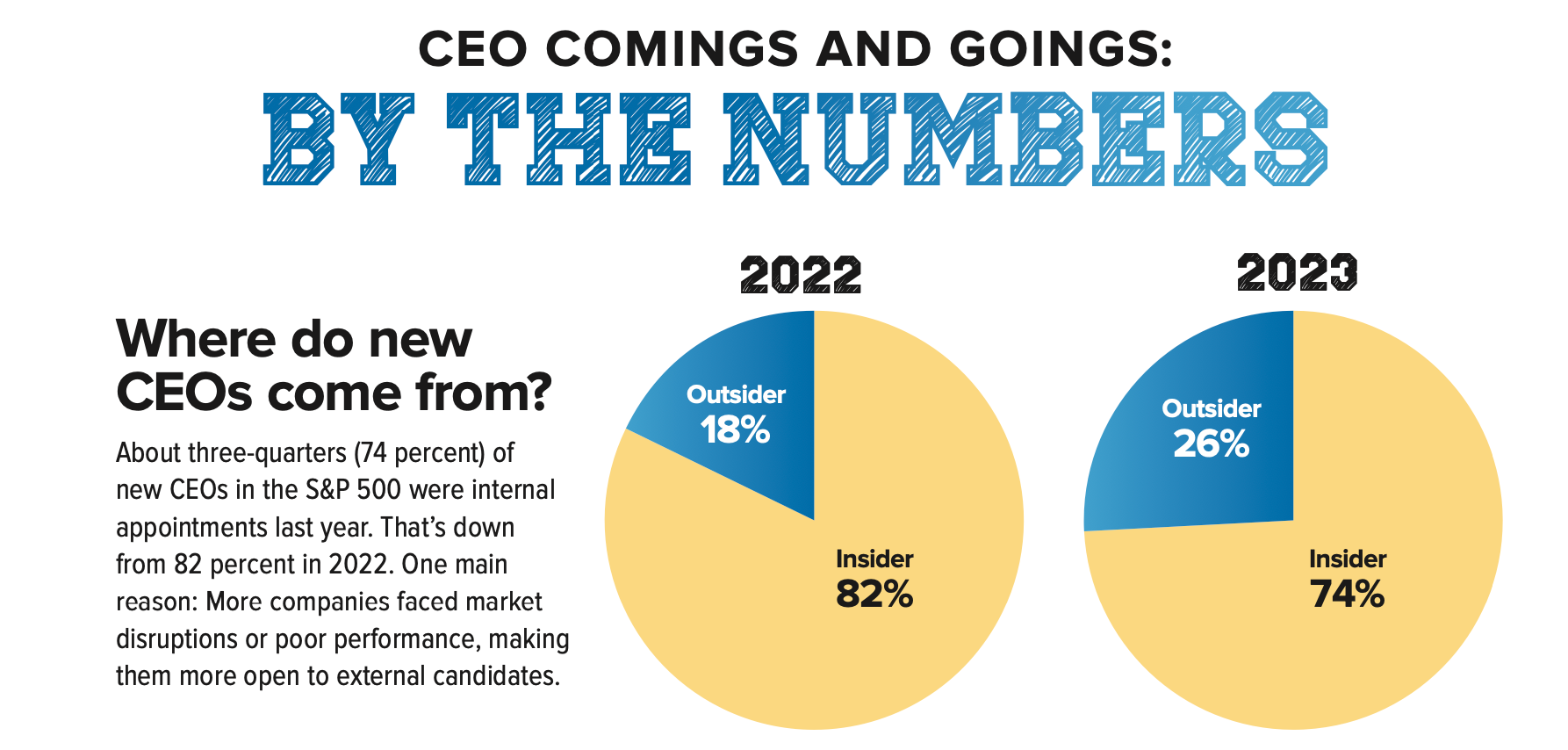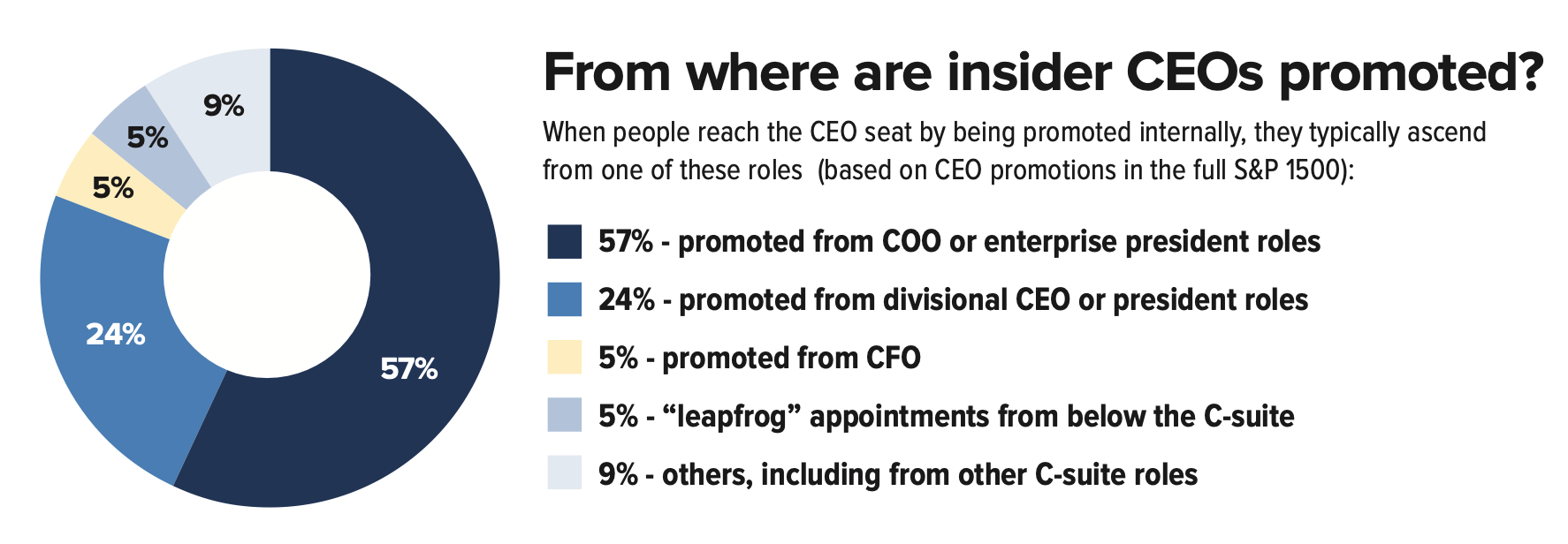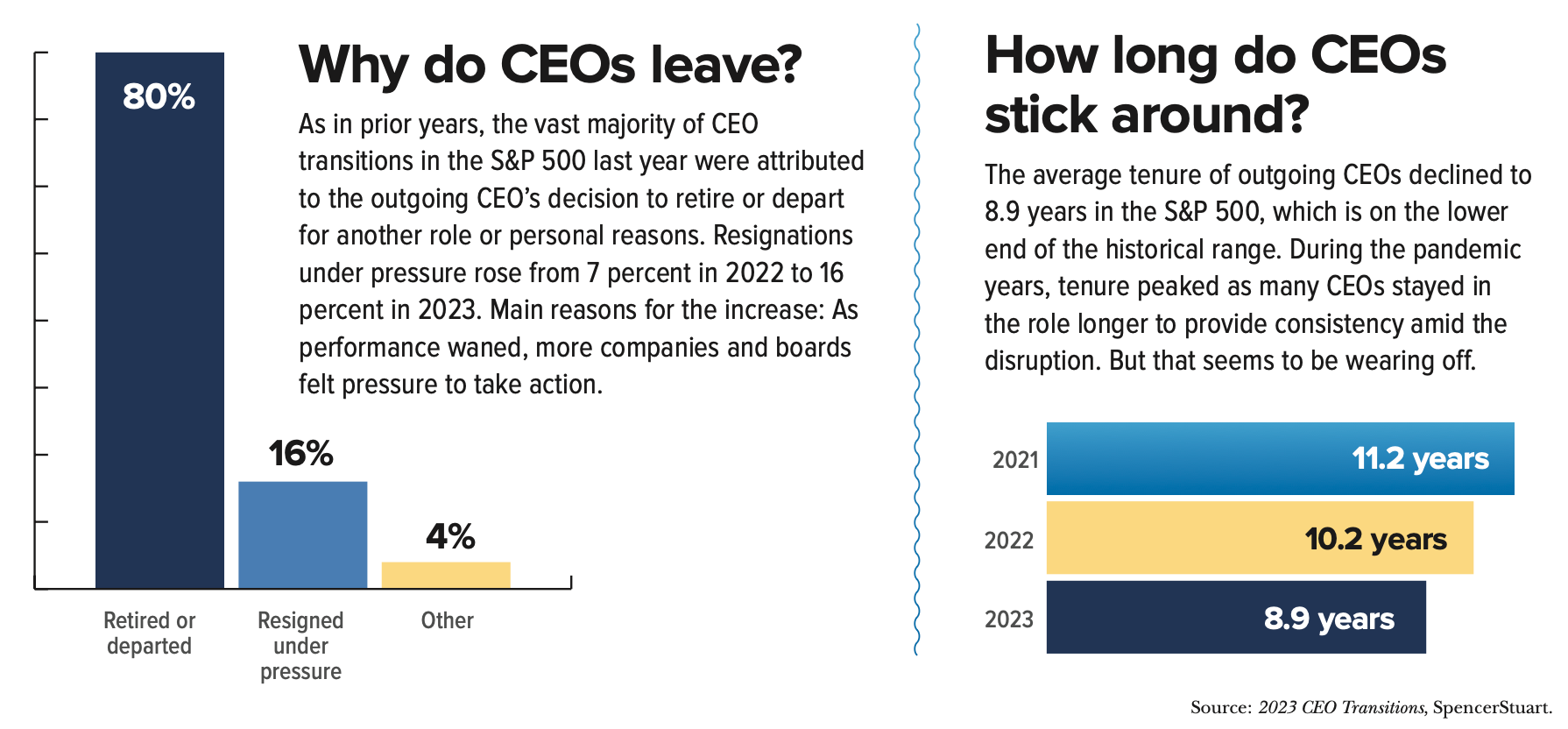A CHRO's Playbook for CEO Transitions
A veteran CHRO who has managed four CEO transitions in her career—including one that played out on national TV—highlights five important lessons for successfully handling change at the top.

In the fall of 2015, I was standing next to the president of the University of Missouri as he resigned—on national television. This was his sudden response to a high-profile race-relations debate on campus after he had become the focus of the student demonstrations, which included a serious hunger strike.
I was the CHRO, and the president had informed me about his intention to resign just an hour before the press conference that ran live on CNN. Most of the C-suite and board members in the room were completely taken by surprise.
Needless to say, there was no planned transition and, unfortunately, no interim successor ready to step in. Given the volatility and public scrutiny of the situation, the university needed to provide an immediate response, but it had to be the right person for the situation.
Immediately, the board and my C-suite colleagues turned to me for guidance and advice. Dodging media interview requests, I gathered some leaders and secured external resources, and we began to figure out how to respond in a matter of hours.
Luckily, this wasn’t my first unplanned CEO transition, although having only hours to prepare was something unique. A few years earlier, the previous university president—a former Fortune 100 CEO—suddenly resigned after less than two years due to a family medical issue.
From both departures, I learned valuable lessons about managing executive transitions, particularly in sudden departures. These five lessons also apply to well-planned transitions—you just have more time to focus, plan and communicate. These lessons must be shared responsibilities between the CHRO, C-suite and the board.
Lesson 1: The CHRO is critical in CEO transitions, serving as a linchpin between the C-suite and the board.
The CHRO is vital in these situations mostly because the CHRO is in unique—and often conflicting—roles, serving several constituencies including subordinate to the CEO, valued confidante to the CEO, colleague of the C-suite team and objective voice to the board on various “people issues.”
Successful CHROs maneuver through these roles, establishing a confidential and confidante relationship with the CEO, setting clear boundaries with their colleagues, and operating with integrity and transparency. These behaviors are never more critical than during a CEO transition, because those multiple roles must be appropriately leveraged during the process.
Lesson 2: Ensure a succession plan is established, documented and communicated, with a focus on interim candidates for unplanned situations.
Most organizations have a long-term succession plan for the development of potential executives. However, organizations rarely focus on the “what if” scenarios that are more immediate.
In my case, when I started at the university, the new president met with the board and wisely asked about the succession plan from an immediacy perspective. “What happens if I get hit by a bus?” he asked. And while his bus example was wrong, he did have to suddenly leave within days of a family situation. The notion that he could suddenly leave was not something the board thought was a top priority, and it was not prepared to handle the situation when he did leave.
The CHRO must be the keeper of the succession plan and be well versed in the current leadership’s assessment, availability and performance. We should also have a unique and objective view of the skills, knowledge, values and gaps within the leadership team, along with the board’s expectations for the future. This information is important in any CEO transition, but never more so than in an unplanned one.
In an unplanned transition, there is typically a need for an interim leader. Depending on the organization’s current priorities and challenges, this might be someone who is not a candidate for the CEO job. In my examples, both interim CEOs were perfect for the time and situation, but they were not perfect for the long-term position. Managing the “ask” of the interim candidates is a delicate matter if, in fact, the board does not view the candidate as a long-term CEO for the organization. Make sure your succession plan has a focus on interim possibilities for a variety of situations and that the board is aware of those options.
In addition to “who,” there must be a parallel plan for “how.”
Lesson 3: Manage the inevitable “Grant me one wish” requests.
If you have been through an executive transition, you know that many C-suite leaders and managers in the organization use that opportunity to lobby the new leader for resources or policy changes or simply try to curry favor from the new leader, often providing a one-sided view.
When a new CEO arrives, it reminds me of the wedding scene in the movie “The Godfather.” The godfather spent time allowing various people to ask for favors or “pardons” to be granted. The CHRO should play the role of the godfather’s lawyer in that scene, sitting beside the CEO, listening to the requests, consulting on what’s reasonable, providing historical context and helping to avoid land mines. Depending on the relationship between the CHRO and the C-suite, this discussion might occur after the requests have been made to the CEO.
In a planned transition, there is time to talk to your colleagues about how to best onboard the new CEO and how they should manage initial meetings with the new leader as a group.
In my experience, those requests can pop up quickly during unplanned transitions. And because the interim CEO typically comes from the current C-suite leadership team—or at least is well known to them—there is an opportunity for leaders to try to leverage past relationships. The CHRO can plan for this partially through the succession plan process, but also from our relationships with the C-suite, especially our understanding of how various C-suite members will react to the new interim CEO. More on this in Lesson 5.
Lesson 4: Control the communications resources and be the coordinator.
In the case of an unplanned exit by the CEO, communications must be controlled, centralized and immediate. If you do not have adequate internal communications support or the issue requires external crisis management, secure resources immediately. It should be your first action!
The second equally important task is developing the messages and ensuring alignment with the board. In the case of my one-hour transition at the university, there was disagreement among board members and campus leaders about how and why his resignation occurred, leading some to talk to the media on their own. I had to bring together various leaders to reach agreement on centralized and coordinated messaging as well as to establish clear roles and responsibilities. The crisis management team had their hands full just trying to contain the various parties, not to mention trying to develop centralized and accurate messages.
In addition, some board members were reaching out to potential interim candidates without my knowledge or without support from other board members. This created additional work for me and other leaders in managing the expectations of the various potential interim CEOs. I had to rely on my established relationships with these board members to assure them I was the neutral place for these discussions and they must do so through me. The board members were trying to do the right thing but going about it in a disjointed manner.
Lesson 5: Regardless of your opinions, keep an open mind on the process and options.
This last lesson was my most important. When the first CEO told me he needed to leave for family reasons, he also shared his recommendation for an interim. I panicked. This was not someone who had much experience as a C-suite executive and, in fact, was not well liked by some of the C-suite, including me.
When I expressed this to the CEO, he gave me reasons why he thought this was the best option, including that this individual would not be a candidate for the long-term CEO job and that he had board support. I trusted the CEO, so I decided to bury my feelings and make it work. And he was right. His choice for interim CEO was the perfect leader for that time.
I reached out immediately to support that person, and we quickly established a successful partnership. He wanted to serve the university well, and he did so with humility and trust. He brought stability during a time of need, and that positioned us well for the new CEO.
This lesson also works well in a planned transition. You may not support the candidacy of the final CEO selection, but the CHRO must become an immediate and trusted partner. If you establish your role and expectations upfront, you can build a strong partnership.
I find it particularly helpful to be transparent about any concerns I have, as well as vulnerable in sharing my challenges. In both of my examples, the CEOs came from outside higher education, so I was able to “translate” the language, processes and even culture differences of higher education for them. I provided a safe place for them to express surprise and concern when they bumped into criticism or unknown territory.
In the example of the second unplanned transition—prior to the public resignation—there were some difficult discussions as the student issues escalated and the CEO was threatening to resign. My CHRO “moment of truth” occurred when a board member appealed to me to get the CEO to not resign. I asked the board member if the board would support the CEO, and he replied, “Some of us would.” That was my clue to move away from the CEO (whom I considered a friend) and provide advice and guidance to the board. This was one of the most difficult situations of my career. Only by focusing on what was best for the organization—and ultimately the CEO—could I navigate objectively and strategically.
The C-suite was also divided in their loyalties, and it fell to me as CHRO to bring us together as a team, focused on the future. Those were difficult and very emotional discussions. In the midst of all of this change, I made my own decision to leave, and it was one of the best decisions of my career.
The bottom line: CEO transitions are some of the most daunting and yet potentially fulfilling experiences for a CHRO. How we plan for the transition, establish our role during the search (planned or unplanned), manage the inevitable issues and remain neutral will determine the success.
Beyond these tactics are basic assumptions that your role as CHRO is firmly established and trusted. It is rare that all parties—board, C-suite and external constituents—align on the best path forward. So, you have to use your position and their trust to take the lead in managing the constituencies and the transition with grace, intentionality and expertise.

Betsy Rodriguez has been a CHRO for 17 years. She has worked for eight CEOs/presidents in higher education and health care and has participated in four CEO transitions.



The Four Priorities of a New CEO
New CEOs always face an onslaught of competing priorities as they start their tenures—unifying new leadership teams, engaging their workforces, affirming their company’s vision and setting direction. To assist in the CEO transition, it’s important for CHROs to understand those priorities.
According to Stephen Miles, founder of the Miles Group, and Deb Bubb, a former HR executive at IBM and Intel, here are the four overarching priorities for every new CEO early in their roles:
Take a seat. Many new CEOs want to jump in and initiate change quickly, but new CEOs should take time to survey the company before activating change. Processes, talent and a broader enterprise view impact how new CEOs see their organization, its opportunities and challenges. Moving too quickly can result in resistance and rejection. This can play out in many ways, including executive team retention issues or reputational harm. So it’s important that new CEOs take time to view their company holistically.
Get personal. Strong onboarding, personally led by the CEO, is key to increasing organizational engagement, capturing early wins and building a foundation for long-term success. New CEOs need a clear view of the role and expectations of the board, investors, customers, their leadership team, and broader employee population. They need a clear view of their own strengths and development opportunities and a trusted advisor or team to help them navigate the early challenges of onboarding.
Be present. It is vital for new leaders to be present and visible to their organizations early on. Little leaders lead businesses, and big leaders lead people. CEOs earn the right to lead employees and the company, and to do that, they must be visible to the broader employee base early and often.
Team first. No CEO succeeds alone, so building a strong leadership team is critical. The early days of a CEO’s tenure offer an important opportunity to build relationships, develop trust and explore the organization’s vision. It also helps develop clarity at the top and drive alignment throughout the organization. New CEOs can accelerate team formation by hosting a leadership offsite event to enable the executive team to agree to rules of engagement, set cultural expectations and become a cohesive unit.



